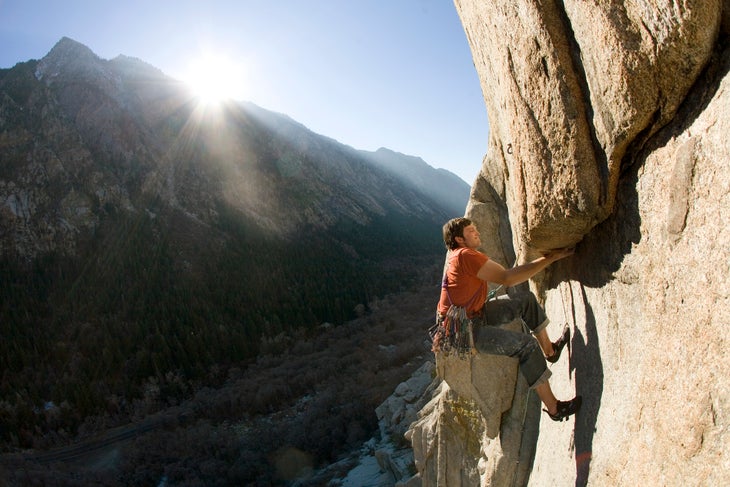Heading out the door? Read this article on the new Outside+ app available now on iOS devices for members! Download the app.
This article originally appeared in the July 2015 issue or our print edition.

Underclings can produce some of the most powerful and bicep-intensive movements in all of climbing. In fact, if you want a photo of yourself looking jacked, have a friend snap one while you’re yanking hard on an undercling. Any hold you use with your palm facing up is considered an undercling; this could range from the totally flat underside of a small roof to a dreamy incut hold behind a flake. Often these holds are simply an edge where the most positive side happens to be at the bottom, or facing down. Mastering these grips and moving off them is extremely useful, if not critical, to being a well-rounded climber. On many routes, the undercling is unavoidable and perhaps even the key to unlocking the route. Or, like the Great Roof on the Nose of El Cap, it could be the entire pitch. Start with these tips to tackle underclings efficiently.
Control Fatigue
Underclinging a thin seam at the back of a roof can be incredibly taxing, whether your feet are smearing on the wall or you’re traversing under a long flake. Just like with any type of climbing, maintain straight arms to keep weight off your biceps and on your skeleton instead. Find a good, positive foothold? Transfer more of your weight to it and take a quick rest. Pay attention to your grip, too. Instead of crimping, try an open-hand position, getting as much of your hand as possible behind the hold. It’s also possible that your calves will start screaming, so sink your heels down for a relieving stretch and to increase rock-rubber contact. Then try bringing your feet higher so your hips are at about 90°.
Pull-push
Grip the upside-down hold with your palm facing up and your thumb pointing outward, away from the centerline of your body. Use your hands to pull out from the wall and direct pressure toward your feet so you can push with your lower half. This is the undercling in its most basic form, and it should feel pretty natural. Essentially, you are using counter-pressure, body tension, and the friction of your shoe rubber to stay on the wall.
Position and Tension
Underclings work best if the handhold is near your midsection. The higher the undercling is, the more off-balance you will feel until you move your body up to be even with the hold. An effective undercling requires body tension and opposition, or counter-pressure. As you get your hands and feet solidly in place, engage your core. Most undercling movements will utilize one hand to maintain balance while trying to reach with your other hand. This also puts your arm and body in a naturally strong position. If you’re underclinging with your left hand, press with your right foot, smearing or edging or whatever you need to do to get the best purchase. The optimal scenario is having the left undercling at about waist level and back-stepping with the outside edge of your right foot, which should provide more reach. Flag with your left foot (or use an available foothold) and turn your right hip into the wall as you stand up on your right foot to reach with your right hand.
Believe in Your Feet
The same as in slab climbing, trust your rubber. In fact, put more weight on it. Now even more. This will make the blankest sections of rock usable.
Overachieve at Underclings With Tips From Mayan Smith-Gobat
Mileage

One particular route comes to mind immediately: Fuel. It was my first 5.13b, a beautiful, sustained route on smooth, glacially polished granite located in the Darran Mountains in Southern New Zealand. This wall was slightly overhanging with mainly downward-facing features. Nearly ever single left handhold was an undercling, and the feet were all terrible, producing an incredibly technical route that required a lot of power to climb. It took me a long time to work out the subtle foot positions to make the movements possible, and then weeks of effort to build up the power-endurance in my left arm to finish the route. Fuel is still a very memorable experience for me, one where I learned a huge amount about underclings and how to use them more competently.
Experiment
It’s all about footwork, balance, and getting your body in the right position to use the hold effectively. It can be very subtle—a tiny adjustment in foot position can make a huge difference in being able to reach the next hold. Each undercling is unique, so each takes some experimenting.
Body tension
The higher you can get your body in relation to the hold, the easier or less powerful underclings become. Rather than pulling with your arms, move your feet higher up and stand up hard into the hold. A smooth undercling move comes from your legs and body tension. Focus on keeping your entire body tight.
Smearing
When there are defined footholds to stand on, the whole process is much easier, but traversing an undercling crack or rail can present a lack of any real footholds, and smearing on a blank wall is often necessary. Focus on pressing your feet directly into the wall. Do not stand down, like you would on a typical foothold; instead, stand into the wall at 90° and remember that the foot might feel like it’s slipping until it is fully weighted. Press in with all your strength, keeping tension between your feet and hands.
Mayan Smith-Gobat has been climbing for over 20 years. She holds two speed records on the Nose and currently calls Colorado home.